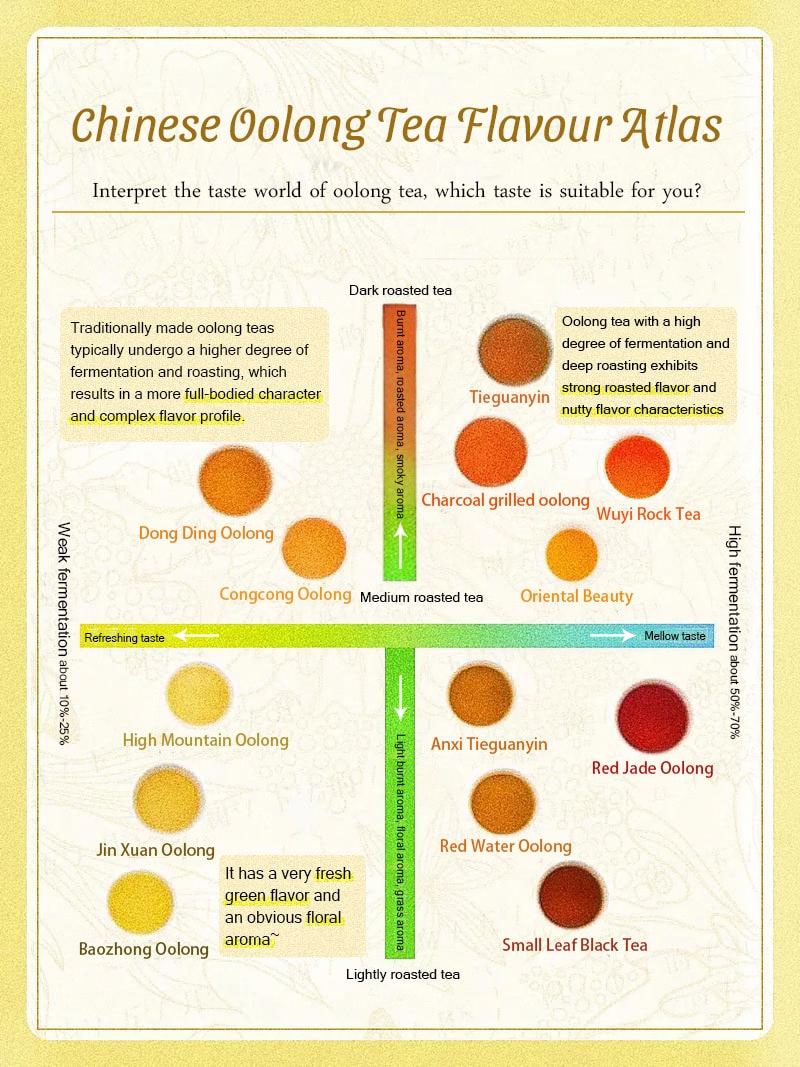
What Is Oolong Tea? Benefits, Flavors, and Brewing Tips
刘洁杭Share
Oolong tea is a Chinese tea that’s partially oxidized. So, what is oolong tea? The unique oolong tea processing techniques give it special flavors and aromas. Read on to learn more about its history, benefits and brewing tips.
Quick Facts
- Oolong tea is a semi-oxidized traditional Chinese tea, with a special process that gives it many flavors and aromas.
- The process of oolong tea involves withering tea leaves, rolling, oxidation, roasting, and drying, each step contributes to its unique profile.
- Good for weight loss, brain function and oral health.
Understanding Oolong Tea

Oolong tea is a Chinese tea, famous for its partial oxidation. This tea is made from the Camellia sinensis plant, the same plant as green and black teas. What sets oolong tea apart is its unique processing which puts it somewhere between green and black teas in terms of oxidation. Unlike green teas, which are minimally oxidized to preserve their fresh flavors, oolong tea can exhibit characteristics similar to both black and green teas depending on its oxidation process. This is what gives oolong tea its flavor and aroma and that’s why tea lovers love it.
The name oolong or ‘black dragon’ adds a mythical touch to this tea. This name comes from China where it was first crafted during the Ming Dynasty for the Emperor and his court. This historical background not only gives the tea its prestige but also its importance in Chinese culture. Drinking oolong tea daily is not just a habit but a tradition.
Oolong Tea History
Oolong tea was first recognized in the 18th century for its unique characteristics. Tea cultivation played a crucial role in the history of oolong tea, particularly in regions like Taiwan and Fujian Province, where the unique climate and geography influence the quality and characteristics of the tea. Production started in Fujian Province, China during the Ming Dynasty where the processing techniques were developed for this special tea. These techniques have been passed down through the generations to preserve the tradition of oolong tea.
In the 19th century oolong tea production expanded to Taiwan. Taiwan introduced new cultivation methods and flavors to oolong tea. Over the years oolong tea has evolved into many different types, each with its own characteristics and now part of the tea culture worldwide.
Origins in China
Oolong tea dates back to the Ming Dynasty when it was made for the Emperor and his court. The tea plant, specifically its various cultivars and growing conditions, plays a crucial role in the development and characteristics of oolong tea. The term ‘wulong’ comes from the 1857 text Miscellaneous Notes on Fujian. So it’s deep in Chinese tea history.
Fujian Province is still a major tea growing area and produces some of the best oolong teas today.
Spread to Taiwan
Oolong tea was introduced to Taiwan in the 19th century and that marked the beginning of a new era of oolong production. Taiwan’s varied climate was perfect for oolong tea and that’s why it expanded so much.
Today, Taiwanese oolong teas are celebrated for their unique flavors and high quality, reflecting the island’s dedication to this cherished tradition.
Unique Characteristics of Oolong Tea
Oolong tea is known for its semi-fermented nature, with oxidation levels that vary significantly between 1% and 99%. This partial oxidation process is what gives oolong tea its unique flavor and aroma, distinguishing it from both green and black teas.
The meticulous oolong tea production involves multiple steps, including withering, oxidation, rolling, roasting, and drying, each contributing to the tea’s distinctive profile.
Partially Oxidized Tea
Oolong tea is partially oxidized, which puts it between green and black teas in terms of oxidation. This semi-fermented state comes from withering and then bruising the leaves by rolling, which starts the oxidation process. The process is carefully controlled, the leaves are then wok-fired to stop oxidation at the desired level. This attention to detail helps to develop the tea’s flavors and aromas.
Oolong tea can be anywhere from barely oxidized to almost fully oxidized. This range allows for a wide spectrum of flavors and aromas, making oolong tea a fun tea for tea lovers. The partial oxidation is what gives oolong teas so much diversity.
Flavor Profile

Oolong tea flavor is super diverse, floral, fruity, earthy and robust. Lighter oolongs are sweet floral and fruity, with a fragrant aftertaste that’s refreshing and delightful. For example, Da Hong Pao oolong is earthy and floral, that’s how deep Chinese oolongs are.
Taiwanese oolongs are generally lighter in flavor with a greener appearance than Chinese oolongs. Teas like Bao Zhong, which is slightly floral and crisp, shows the delicate finish of Taiwanese oolongs.
The rolling and roasting processes play crucial roles in developing these flavors, enhancing the tea’s unique characteristics and ensuring a memorable taste experience.
Oolong Tea Production Process

The production of oolong tea is a meticulous process involving several key stages: withering, rolling, oxidation, roasting, and drying. Each step is crucial in developing the tea’s distinctive flavor and aroma.
The entire process usually spans two to three days, during which the tea leaves undergo significant transformations that contribute to the final product’s unique characteristics.
Withering and Cooling
First step of oolong processing is withering tea leaves to remove moisture from the leaves. This is done by exposing the withered leaves to direct sunlight for a short period then move them to a shaded area for controlled drying.
This step is important to prepare the leaves for rolling and oxidation.
Rolling and Oxidation
After withering, the leaves are rolled and tumbled to break the cell walls and allow oxidation. This step is key to the flavor profile of oolong tea.
Basket-tossing and wok-firing are used to control the oxidation process to get the desired flavor and aroma.
Roasting and Drying
Last stage of oolong tea production is roasting and drying the leaves to stop oxidation and develop the tea flavor. Roasting brings out the taste and preserve the leaves by removing any remaining moisture.
This step is important to keep the tea rich in flavor and aroma for tea lovers around the world to enjoy.
Health Benefits of Oolong Tea

Oolong tea offers a variety of health benefits, making it a valuable addition to a daily routine. Its potential advantages include aiding in weight loss, enhancing mental alertness, and promoting dental health. The antioxidants in oolong tea provide protective effects against cellular damage, while its caffeine content can boost focus and energy levels.
Weight Loss
Oolong tea can support weight loss by promoting fat oxidation and increasing metabolism. Studies suggest that the combination of caffeine and catechins in oolong tea can enhance calorie burn and fat oxidation, aiding in weight management.
Although more research is needed, these properties make oolong tea a popular choice for those looking to manage their weight.
Mental Alertness
The caffeine content in oolong tea can help improve mental alertness and focus. By promoting energy and concentration, oolong tea can be a great choice for those needing a mental boost during the day. Its balanced caffeine levels provide a gentle yet effective way to stay alert and focused.
Dental Health
Regular consumption of oolong tea can contribute to improved dental health. The fluoride content and high levels of antioxidants in oolong tea help prevent tooth decay and inhibit bacteria linked to dental plaque.
Incorporating oolong tea into your daily routine can be a simple and effective way to promote oral health.
Types of Oolong Tea
Oolong teas come in a variety of types, each offering a unique flavor and aroma profile. From robust and roasted to floral and round, oolong teas cater to a wide range of taste preferences.
The ability to re-steep oolong tea leaves for multiple infusions further enhances the flavor, making it a versatile and enjoyable tea.
Chinese Oolong Teas
Iron Goddess of Mercy and Big Red Robe are two notable Chinese oolong teas. Iron Goddess of Mercy is smooth and floral while Big Red Robe is woody.
These teas highlight the rich diversity and depth of Chinese oolong varieties.
Taiwanese Oolong Teas
Taiwanese oolong teas like Bao Zhong and Da Yu Ling are famous for their unique characteristics and quality. Bao Zhong (also known as Pouchong) is lightly oxidized and floral and aromatic.
Da Yu Ling, with its high mountain heritage, offers a smooth, creamy flavor that delights the palate. These teas exemplify Taiwan’s dedication to producing refined and exquisite oolong teas.
Caffeine Content in Oolong Tea
Oolong tea generally contains between 30 to 50 mg of caffeine per 8-ounce cup, making it a moderate caffeine option compared to green and black teas. The caffeine level in oolong tea is higher than that found in green tea but lower than in black tea.
Factors such as brewing methods and steeping times significantly influence the caffeine levels, allowing tea drinkers to tailor their caffeine intake based on their preferences.
How to Brew Oolong Tea
Brewing oolong tea requires attention to detail to unlock its full flavor potential. The steeping time and number of steepings can affect the tea’s caffeine content and taste.
Proper brewing techniques ensure a delightful and aromatic cup of oolong tea.

Steeping
Steeping oolong tea requires specific steeping instructions. Most oolong teas steep best at 210°F, with a range of 195°-215°F. Steep for 10s for best flavor and aroma. One teaspoon or 6 grams of loose leaf tea per cup.
A more robust flavor can be achieved by using one tablespoon of loose leaf oolong tea per 8-ounce cup. This measurement is ideal for Western-style brewing, ensuring a rich and satisfying tea experience.
Re-steeping
Re-steeping oolong teas multiple times often enhances their flavor with each subsequent steep. The best steeping time for re-steeping oolong tea is during the 4th or 5th infusion, allowing the leaves to fully release their complex flavors.
This also makes the most of the fresh tea leaves and allows you to enjoy the tea’s changing taste profile.
A cup of good tea can often become the most intimate companion. Therefore, I would like to recommend our store's selected oolong tea series to everyone.
Huangzhixiang Dancong Oolong Tea 500g/$380
Therefore, you may want to make yourself a cup of our oolong tea when you are busy, and let this gift from the tea mountains become a bright spot in your life.











